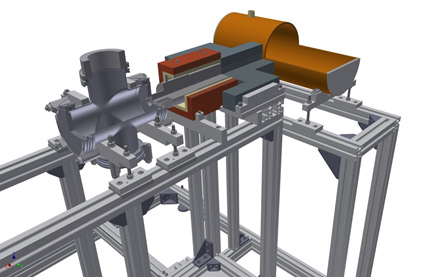The Cherenkov effect for TOF-PET
The Cherenkov effect is well known and used in many detectors in hadron and particle physics (e.g. PANDA-DIRC). Nevertheless, it has not been used for detection of gamma rays, especially at low energies. We are evaluating the Cherenkov effect for implementation into a TOF-PET system, in which the electrons, ionized by the impinging 511 keV gamma-quanta, emit Cherenkov photons, when they are propagating faster than the speed of light in the detector medium. As this emission takes place immediately after the photoelectric effect, the Cherenkov photons are promising to improve the overall timing performance of TOF-PET as it bypasses the relatively long lasting scintillation processes in inorganic scintillators.

For evaluation of the potential of this effect we performed comprehensive simulation studies using Geant4, in which the improvement of Cherenkov photon detection on the time resolution in PET was determined quantitatively, as shown in the picture. Furthermore, a proof of principle measurement using lead glass as Cherenkov radiator has been performed.
Based on the simulation studies and the proof of principle new promising Cherenkov radiators have been found and are currently under testing. Using these new materials with a high yield of Cherenkov photons the proof the principle is tried to be repeated using SiPM (analog and digital) in order to profit of their good timing performance and the possibility to arrange them in highly segmented and compact PET detectors which resulting in an improved timing performance and better background reduction. Furthermore, hybrid TOF-PET-MRI systems could be built, due to the insensitivity of SiPMs to magnetic fields.
This method not only is interesting for TOF-PET but also can be used in fast, low-energy particle detectors in basic research.
Prompt gamma emission of charged particles
In ion-radiation therapy no satisfying method exists for real-time range monitoring. The PET monitoring, which is implemented in a few facilities for this purpose, has its drawbacks like the so-called wash-out effect, which causes excited atoms to be transported away from their original position in the time between excitation and emission of radiation.
This effect can be avoided by using prompt radiation (timescale of 10-9 s after their excitation). This radiation can consist of prompt gamma radiation. These photons are emitted by excited target or projectile particles all along the ion path, with a maximum intensity at the end of the ion range, at the Bragg peak. By detecting the emitted photons, the Bragg peak and with that, the range of the ions should be calculated.
The feasibility of the prompt gamma detection was studied with the GATE simulation framework (GEANT 4 based framework for simulating the passage of particles through matter). The study of the prompt photon spectrum shows that the energy range from 2.3 to 6 MeV is promising for getting information about the ion range. At energies lower than 2.3 MeV, the emission of the photons does not exhibit a peak structure in the region of the Bragg peak and scattering effects inside of the target are stronger for lower energies. For higher energies than 6 MeV, a larger part of the photons are produced outside of the beam, which is also an unwanted effect.
The feasibility of detecting the Bragg peak with cylindrical detectors with lead collimators has been investigated. The detectors were aligned in the plane perpendicular to the beam. The produced photons as a function of depth in the target have been calculated from the detected photons. This scheme has been tested with a cylindrical water target and carbon ion projectiles with varying energy. Depending on the energy, an accuracy of the calculation of the depth of the Bragg peak of a few millimeters was achieved. The next steps in this project would be to optimize the detector geometry and to verify the simulations with experiments.
